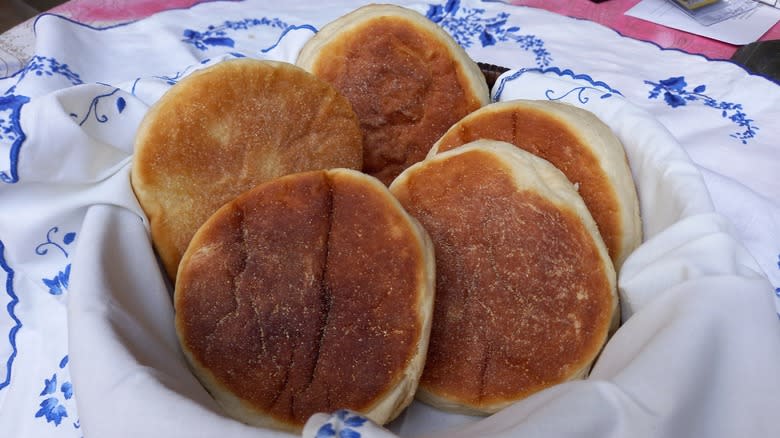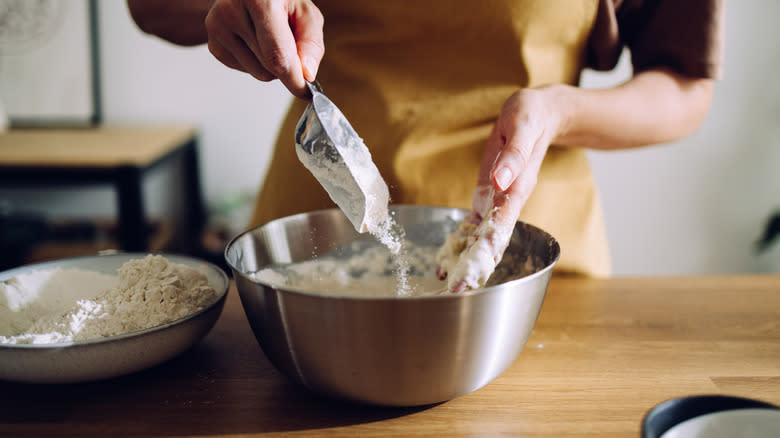Bolos Lêvedos: The Portuguese Lookalike Of English Muffins

Bolos lêvedos are a type of Portuguese bread that, from the outside, look very similar to English muffins. They're shaped like a circle, measure around an inch tall, and have a toasted top and bottom. One difference is that bolos lêvedos are a couple inches larger in diameter, and won't have that familiar dusting of cornmeal like English muffins do. This circular bread is also very different on the inside. It's moist, fluffy, and slightly sweet. Yet it has a certain density and pleasant chewiness about it.
Bolos lêvedos originate in the Portuguese Azores island. They famously come from Furnas, a small town on the island of São Miguel. Their name translates to yeast cakes, which is very representative of what they are: a leavened bread with a cake-like sweetness and hybrid texture. Although they aren't completely widespread in the United States today, they have a larger presence in Massachusetts, where Portuguese immigrants settled around Cape Cod and enjoy a familiar favorite.
Unlike English muffins that have a very airy crumb with nooks and crannies, bolos lêvedos' lack big air pockets and have a softer texture due to their higher egg and butter content. Bolos lêvedos also have a higher sugar content. Whereas a standard English muffin recipe will call for a couple of tablespoons of sugar at most, a batch of eight to ten bolos lêvedos can have around 1 cup of sugar. This subtle sweetness is one of the defining qualities of a bolos lêvedos that merits its 'yeast cake' name.
Read more: US Foods You Surprisingly Can't Find In Canada
Making Bolos Lêvedos Is A Piece Of Cake

Although bolo lêvedo is a unique bread recipe that you may have heard of before, it is quite simple to make. Bolos lêvedos contain basic ingredients including flour, salt, sugar, eggs, milk, butter, and yeast. Their preparation is very similar to that of any other enriched and leavened bread, involving kneading, rising, and proofing. First, all the ingredients should be combined into a very wet dough, kneaded, and then given the chance to rise so that the dough nearly doubles in size. After rising, the dough can be given another quick knead before being shaped into disks about three inches in diameter. These disks will be proofed once more to get a chance to expand a couple more inches before cooking.
Similar to English muffins, bolos lêvedos are cooked on the stovetop. Although they can also be thrown into the oven for a combination of cooking methods to ensure they are cooked through, but still the stove is the traditional way. The circular rounds of dough should be cooked on medium-low heat to ensure that they don't burn. The goal is a dark golden-brown crisp on either side of the bread and an interior that is fully cooked. Tearing it open should reveal a soft and fluffy bread with a density reminiscent of a cake.
Enjoy Bolos Lêvedos From Breakfast To Dinner

The best thing about bolos lêvedos is their pleasant texture and flavor, which sets them up to be enjoyed in meals throughout the day. Bolos lêvedos are tasty and satisfying to eat completely on their own — when they're fresh and warm, they're even more of a delight. To level up, you can enhance the flavor of bolos lêvedos with a bit of butter and jam (they're often cut in half like a bagel, toasted, and topped with these condiments). Paired with a cup of coffee, bolos lêvedos are representative of a typical breakfast in Portugal.
Yet, bolos lêvedos also make for interesting sandwich bread, too. Their fluffy texture and slight sweetness provide balance to salty and savory meats and cheeses. For instance, they can be used to house a breakfast sandwich with a fried egg, ham, and cheese or a lunchtime meal with some turkey and Swiss inside. Alternatively, when used as a burger bun, bolo lêvedos have a similar effect to brioche that complement the richness of beef.
Read the original article on Mashed.

